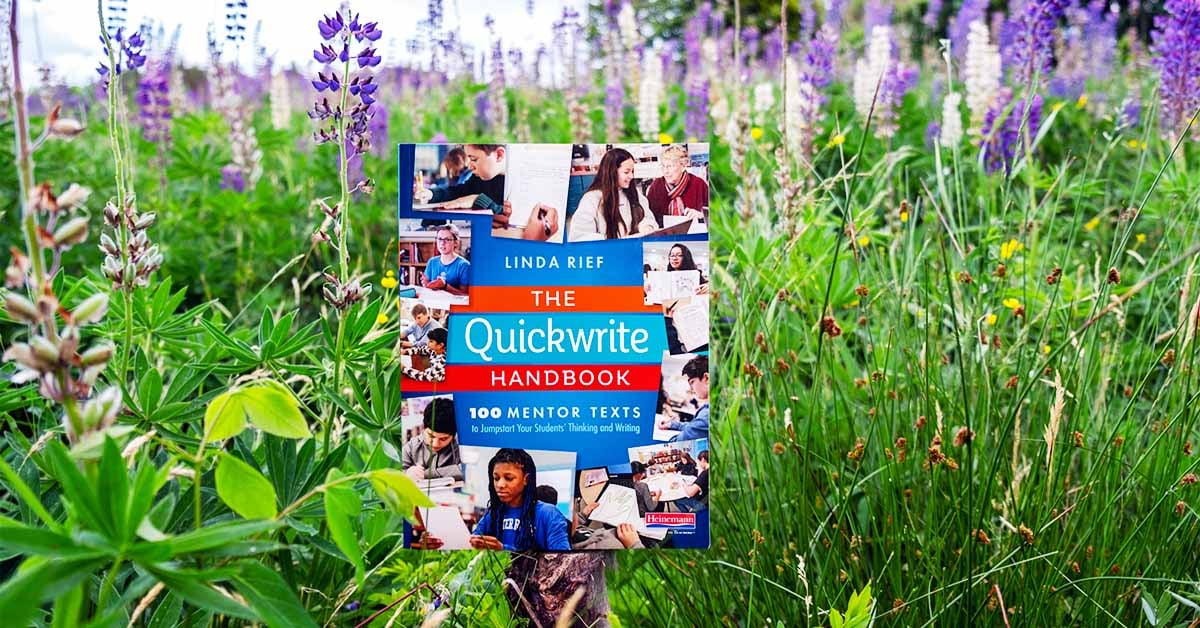
From The Quickwrite Handbook by Linda Rief
At the start of the new school year, students often struggle to leave "summer mode" and re-enter a mindset of learning and growth. Writing in particular can be challenging for students early in the year. "What do I write about?" "I have nothing to say." "I haven't written all summer." Quickwrites can be incorporated into your writing instruction at any time to spark students' creativity and energy, making them an accessible and readily available tool.
A quickwrite is a first draft response to a short piece of writing, usually no more than one page of poetry or prose, a drawing, an excerpt from a novel or a short picture book. They offer an easy and manageable writing experience that helps both students and teachers find their voices and develop their confidence.
When the models for quickwrites are compelling, students are able to focus closely and write clearly. Pieces selected for quickwrites are best as complete works, not stand-alone phrases or three-word prompts. Students need to see, most of the time, a whole piece that is thoughtfully and carefully crafted. The selections need to be practical (tied to the kind of writing you would like students to try), accessible (pieces you know the students can connect to), and provocative (stimulate thinking or feeling in the student). They need to see something that touched them intellectually, aesthetically, and/or emotionally. Adolescents are in the throes of immense physical, emotional, intellectual, and social growth. The pieces of writing we choose to share with them should be ones with which they can connect on many of these levels. The most valuable sources of quickwrites are short works that are:
- language rich
- strong on sensory imagery
- evocative of strong feelings
- thought-provoking
- relevant and compelling to adolescents' interests
When carefully chosen, quickwrite models also demonstrate the craft lessons we want to teach students: careful organization, compelling leads and endings, effective word choice, unique ways of framing or presenting a piece of writing, strong nouns and verbs, stylistic devices or craft moves, even conventions of language—or breaking the rules when done with intent.
Thoughtfully selected, quickwrite models invite students into writing in a way that encourages critical reading as they commit their voices to paper and grow as writers. Use the writing of professionals, the writing of former students, and your own writing to stimulate thinking for quickwrites. In her journal, Maggie, and eighth grade student, wrote, “I had never done quickwrites before, and because of the limited time given I’ve found myself writing things I didn’t know I knew or felt. They really help me get a sense of who I am and help me come up with ideas.”
That is the power of a well-chosen quickwrite model.
•••
Learn more about The Quickwrite Handbook on Heinemann.com
 Linda Rief teaches middle school in Durham, New Hampshire and is an instructor in the University of New Hampshire’s Summer Literacy Institute. A national and international presenter on issues of adolescent literacy, she is also a recipient of NCTE’s Edwin A. Hoey Award for Outstanding Middle School Educator in the English Language Arts.
Linda Rief teaches middle school in Durham, New Hampshire and is an instructor in the University of New Hampshire’s Summer Literacy Institute. A national and international presenter on issues of adolescent literacy, she is also a recipient of NCTE’s Edwin A. Hoey Award for Outstanding Middle School Educator in the English Language Arts.
Her newest book is The Quickwrite Handbook: 100 Mentor Texts to Jumpstart Your Students' Thinking and Writing. She is also the author or coeditor of many Heinemann titles, including Read Write Teach, Inside the Writer's-Reader's Notebook, The Writer's-Reader's Notebook, Adolescent Literacy, Vision and Voice, and Seeking Diversity.
Follow Linda on Twitter @LindaMRief



